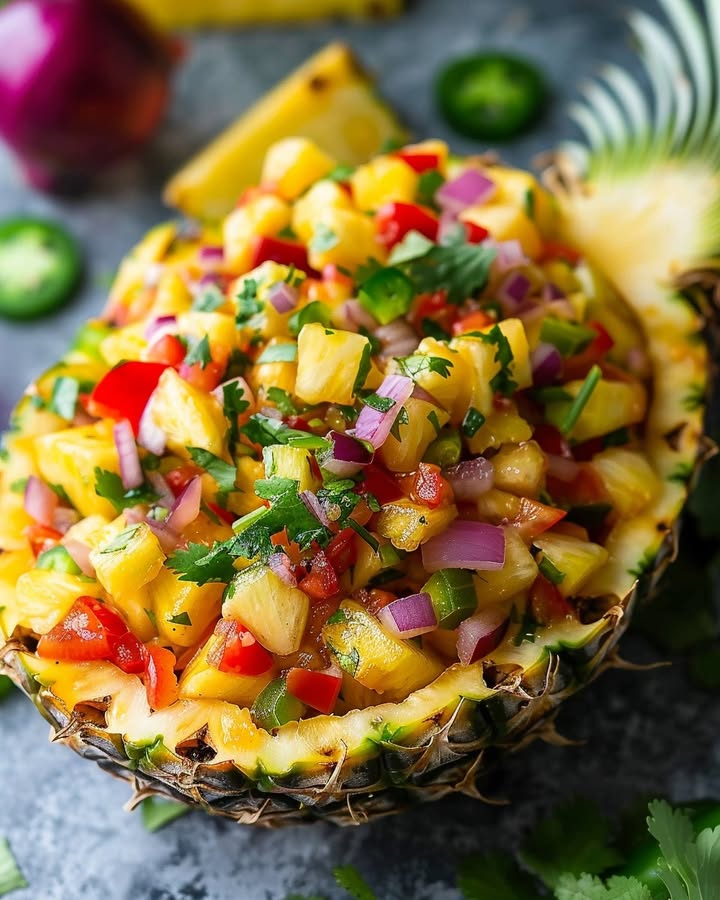Tropical Pineapple Salsa: A Burst of Flavor in Every Bite
Welcome to a sunny escape through flavors with our Tropical Pineapple Salsa recipe. This delightful dish brings together the sweetness of fresh pineapple combined with a kick of heat from jalapeño, creating a vibrant symphony that captures the essence of summer in every bite. Whether you’re serving it as a topping for grilled fish or as a zesty dip at a fiesta, Tropical Pineapple Salsa is a fantastic way to infuse colorful fun into any meal.
The invigorating blend of ingredients, from crisp bell peppers to fragrant cilantro, makes this pineapple salsa a multi-sensory experience. Each mouthful delivers a refreshing juxtaposition of sweetness and spice, a combination that stimulates the palate and energizes the senses. Prepare to be amazed at how this simple, yet exotic salsa elevates your culinary repertoire, turning ordinary gatherings into memorable feasts.
Quick Recipe Highlights
- Flavor Profile: The Tropical Pineapple Salsa is a perfect balance of sweet, spicy, and tangy. The juicy pineapple provides a natural sweetness contrasted by the fiery hint of jalapeño.
- Texture: Enjoy the satisfying crunch of bell peppers and red onion, which add an exciting texture to the creamy chunks of avocado.
- Aroma: Fresh cilantro and lime juice impart a refreshing fragrance, evoking the aromas of a tropical island.
- Visual Appeal: The vibrant colors of fresh pineapple, red bell pepper, and green cilantro create an inviting and eye-catching dish.
- Skill Level Needed: This easy recipe is perfect for novice cooks, requiring only basic cutting skills and no cooking experience.
- Special Equipment: No special tools are needed, just a sharp knife and a cutting board.
Recipe Overview
- Difficulty Level: Tropical Pineapple Salsa is easy to prepare, requiring only simple chopping and mixing.
- Category: This salsa makes for a delightfully fresh appetizer or side dish.
- Cuisine: Inspired by tropical paradise flavors, this dish borrows from Caribbean and Latin American influences.
- Cost: With its use of accessible ingredients, this recipe is budget-friendly and perfect for large gatherings.
- Season: Best enjoyed during summer when pineapples are at their ripest, though available year-round.
- Occasion: Ideal for picnics, barbecues, or as a vibrant addition to any casual gathering.
Why You’ll Love This Recipe
The first reason to fall in love with Tropical Pineapple Salsa is its irresistible taste and texture. The contrast of succulent pineapple juice against the zesty lime and spicy jalapeño creates a rush of flavors that dance on your taste buds. Every bite delivers a delightful crunch, thanks to the crisp bell peppers and onions, providing a satisfying chew you’ll relish.
Convenience is key in today’s fast-paced world, and this salsa excels in that department. With a prep time of just 15 minutes, you can whip up this colorful delight at a moment’s notice. It doesn’t require any cooking, which means minimal clean-up afterwards. It’s perfect for busy weekdays or a spontaneous snack for unexpected guests.
Nutritionally, Tropical Pineapple Salsa shines as a health-conscious choice. It’s low-calorie, packed with vitamins and antioxidants, and made entirely from fresh, whole ingredients. The pineapple contributes beneficial enzymes and vitamin C, while avocados add healthy fats and fiber for heart health. It’s a guilt-free indulgence you can enjoy time and again.
The salsa’s social and entertaining value cannot be overstated. Its vibrant presentation instantly enhances any spread, becoming a conversation starter at gatherings. Sharing a bowl invites guests to explore and embrace new flavors, transforming a casual meet-up into a lively social affair.
From a cost-effectiveness standpoint, this salsa makes perfect sense. Its staple ingredients are readily available and affordable, allowing you to feed a crowd without breaking the bank. Plus, its versatility means you can incorporate it into various meals, maximizing the full value of your culinary investment.
Historical Background and Cultural Significance
Salsa has a rich history entwined with Latin American culture, where pineapples are a staple symbolizing hospitality and warmth. Originating from regions where these tropical fruits grow abundantly, pineapple salsa brings a touch of sweetness to customary spicy dishes.
In many Latin and Caribbean cultures, incorporating tropical fruits in cuisine is not just traditional, but an expression of using the land’s natural bounty. Pineapple’s introduction into salsas likely began as a natural evolution of fruit salads popular in these regions, catering to a demand for more complex flavors.
As culinary tastes developed, pineapple salsa became widely adapted across the globe. It was embraced worldwide for its versatility and exotic allure, especially within modern fusion cuisine that blends diverse flavor profiles.
Regional variations have surfaced over time, such as the inclusion of mango or other tropical fruits that enhance the subtropical experience. Still, the core elements of sweet, spicy, and tangy remain, continuing to captivate eager epicureans everywhere.
Ingredient Deep Dive
Pineapple, with its spiky crown and sweet flesh, is the hallmark of this salsa. Originating from South America, pineapples have held symbolism in hospitality and warmth across cultures. This tropical fruit is rich in vitamin C, manganese, and bromelain, an enzyme that aids digestion. Selecting a pineapple, aim for one with a sweet smell and a golden, uniformly vibrant color. Store it at room temperature until ripe, then refrigerate to extend freshness. If unavailable, canned pineapple in natural juice can be a substitute.
Jalapeño peppers bring the heat to this dish and are widely cherished in Mexican cuisine. They’re known for their metabolism-boosting properties, thanks to capsaicin. To choose jalapeños, look for vibrant green, smooth-skinned peppers; refrigerate them in a sealed bag to maintain the best quality. For a milder heat, consider swapping with bell peppers or omit seeds during preparation.
Common Mistakes to Avoid
- Overmixing: This can cause mushiness, diluting textures. Stir gently to maintain a vibrant mix.
- Pineapple Overripe: Use ripe, not overly ripe, pineapple to prevent the salsa from becoming too sweet.
- Ignoring Seed Removal: Jalapeño seeds add extra heat, so remove them unless you prefer a spicier dish.
- Acid Overload: Using too much lime overpowers; start with less, adjust as needed for balance.
- Using Pre-cut Pineapple: Freshly diced pineapple ensures the best texture and flavor.
- Inadequate Chilling: For best taste, chill the salsa before serving, enhancing flavors.
- Overlooking the Avocado: Add right before serving to preserve its fresh appearance and texture.
- Skipping Ingredient Prep: Ensure all ingredients are properly diced for uniformity and ease of eating.
- Not Tasting Before Serving: Taste test ensures proper seasoning, balancing salt, pepper, and lime juice.
- Improper Pineapple Cutting: Avoid cutting too deep, wasting usable fruit; peel thinly and core carefully.
Essential Techniques
Knife Skills are crucial for this dish, emphasizing precise dicing for uniformity and presentation. Mastering your grip and stroke will ensure efficient and safe cutting. Avoid over-chopping which can crush ingredients, releasing excessive juices. Look for even-sized bits as a visual cue for success.
Balancing Flavors involves careful tasting and adjusting. Begin with less salt, lime juice, and spice, then incrementally increase to achieve the desired taste. This safeguards against over-seasoning, a common pitfall when eager cooks overestimate requirements.
Pro Tips for Perfect Tropical Pineapple Salsa
Choosing the Right Pineapple: Opt for fresh, firm pineapples, which deliver both sweetness and texture without excessive juiciness, essential for optimal salsa consistency.
Jalapeño Preparation: Mincing the jalapeño finely will distribute heat evenly throughout the salsa, offering bites of consistent spice without overwhelming any single mouthful.
Quick Cooling: After assembly, place your salsa in the fridge for at least 30 minutes. It allows flavors to meld together seamlessly, enhancing its complexity and refreshing quality.
Presentation is Key: Serve in a brightly colored bowl to draw attention to the mosaic of colors within, making it visually captivating and enticing.
Citrus Boost: Adding lime zest along with juice can intensify zestiness without making the dish too acidic—a subtle brain hack for an extra layer of flavor.
Avocado Addition: Always add avocado just before serving to prevent browning, ensuring it remains visually appealing and creamy in texture for diners.
Variations and Adaptations
Regional Variations can include swaps like using mango or papaya to showcase other tropical flavors. Adjust the sweetness and acidity based on preference and local availability.
Seasonal Adaptations involve incorporating produce at its freshest. Think autumn apples or winter citrus mingled among the core ingredients to embrace the current bounty.
Dietary Modifications: Substitute avocado with cucumber for a lighter version, or add black beans for a protein boost and hearty feel, perfect for vegetarian alternatives.
Flavor Variations such as introducing different herbs like mint or basil can impart unique twists, tailoring the salsa to pair with specific main dishes or themes.
Texture Modifications can be achieved by introducing crunchy nuts or seeds, like toasted pepitas, which add a nutty element to the salsa.
Presentation Alternatives include serving in pineapple boats for an exotic touch or as taco fillers piled high for a vibrant, inviting dish.
Serving and Presentation Guide
Perfect Plating: For an impactful presentation, serve your salsa in a hollowed-out pineapple, showcasing its fresh origin and offering a show-stopping centerpiece.
Garnishing Ideas include sprinkling pomegranate seeds atop the salsa, offering visual contrast and extra bursts of sweetness with every bite.
Traditional Accompaniments: When paired with tortilla chips, this salsa becomes an irresistible dip ideal for shared platters at festive occasions.
Modern Serving Suggestions: Spoon over grilled meats like salmon or shrimp for an elevated main course with vibrant flavor accents.
Temperature Considerations: Ensure salsa is served chilled for optimal freshness, accentuating its refreshing qualities and vibrant flavors.
Portion Control Tips: Offering in pre-measured cups or small bowls encourages moderation in sharing settings, keeping the serving area clean and organized.
Wine and Beverage Pairing
Best Wine Pairings for Tropical Pineapple Salsa include a chilled glass of Riesling or Gewürztraminer for their balance of sweetness, acidity, and bright fruity notes complementing the salsa’s profile.
Non-Alcoholic Alternatives such as a sparkling mineral water with a splash of lime or a ginger beer can mirror the tropical vibe without alcohol, refreshing and vibrant.
Coffee/Tea Pairing: While not typical, a light, citrus-infused iced tea can provide a cooling backdrop, marrying softly with the salsa’s zesty attributes.
Temperature Considerations suggest serving beverages slightly chilled to echo the salsa’s refreshing nature, aiding in cutting through its spicy-hued tang.
Serving Suggestions: Offer beverages in clear, tall glasses to show off any garnish, like lime wedges or mint leaves, that complements the salsa’s ingredients.
Storage and Shelf Life
Proper Storage Methods for Tropical Pineapple Salsa involve transferring any leftovers to an airtight container and refrigerating promptly to maintain freshness.
Temperature Requirements: Keep your salsa consistently cold to preserve its crisp texture; exposing it to room temperature for extended periods is best avoided.
Container Recommendations include using glass storage containers to prevent flavor absorption and maintain optimal freshness.
Signs of Spoilage include discoloration, off-smell, or excess liquid and mushy texture; discard immediately if any of these appear.
Reheating Instructions aren’t applicable, as this salsa is meant to be cold, but can be refreshed with a squeeze of lime before serving again.
Freezing Guidelines: While possible, freezing can soften certain textures; if you choose to freeze, maintain in single-serving packets for easier future use, thawing in a fridge overnight.
Make Ahead Strategies
Prep Timeline involves preparing ingredients up to a day ahead, keeping them separately to avoid moisture buildup, then combining close to serving time.
Storage Between Steps: Dice and store pineapple and onions separately from herbs to prevent them from losing crisp.
Quality Impact Assessment: Mixing just before serving guarantees optimal flavor and texture balance, ensuring no ingredient overpowers another.
Assembly Tips include layering ingredients methodically, with delicate elements like cilantro added last to maintain vibrancy and freshness.
Reheating Guidelines do not apply due to the cold nature of the dish, but allowing it to sit at room temperature briefly may enrich flavors.
Fresh Element Additions: Add fresh avocado or a last-minute squeeze of lime for a flavor lift just before serving, enlivening taste and texture.
Scaling Instructions
Halving the Recipe means reducing ingredient quantities proportionally; remember that fresh-size variables like lemon or lime can vary, so taste before final viral serving to adjust.
Doubling or Tripling is straightforward, but you might need a larger mixing bowl; maintain individual ingredient prep to avoid over-mixing large quantities.
Equipment Adjustments: Use a more sizable cutting board or multiple bowls to maintain efficiency and cleanliness during scaling.
Timing Modifications might involve slightly longer assembly due to volume increase, but prep remains quick if organized methodically.
Storage Considerations suggest dividing and storing in multiple containers to prevent spoilage and ensure freshness is retained when scaling upward.
Nutritional Deep Dive
Macro Breakdown: Tropical Pineapple Salsa is a low-calorie choice high in vitamins A and C, and packed with fibers and healthy fats.
Micronutrient Analysis highlights a wealth of beneficial minerals, such as manganese from the pineapple and potassium from the avocado.
Health Benefits: It’s anti-inflammatory and hydrating, aiding digestion and supporting cardiovascular health while offering antioxidants for immune boost.
Dietary Considerations suit varied diets, being vegan, gluten-free, and adaptable for low-FODMAP restrictions by omitting onions.
Portion Analysis encourages moderation; although minimally caloric, its freshness delivers high satiety, preventing overconsumption.
Weight Management Tips: Use as a salad topper or bulk up with greens to retain flavor while lowering overall caloric intake through additional fresh, low-calorie companions.
Dietary Adaptations
For a Gluten-Free version, ensure any accompanying chips or serving vessels are certified gluten-free and pair with gluten-free crackers or fresh veggies instead.
A Dairy-Free rendition is inherent, a naturally dairy-free delight requiring no alternative modifications to accommodate lactose intolerant diners.
Vegan lovers rejoice, as this recipe is plant-based, offering all the deliciousness of a fresh salsa without any animal products.
Low-Carb modifications involve minimizing fruit quantity and emphasizing bell peppers for crunch without loading up on unnecessary sugars.
The Keto path can maintain pineapple in moderation; increase avocado for added fat, employing higher-fat sides like pork skins instead of chips.
On the Paleo front, replace any processed seasoning with natural spices or herbs, keeping the salsa aligned with whole-food principles.
Low-FODMAP adjustments, crucial for some, can be made by reducing elements like onion and opting for a more cilantro-forward flavor to avoid fermentation triggers.
Troubleshooting Guide
When presenting Texture Issues, consider balancing the salsa’s moisture by adjusting lime juice and draining excess pineapple juice if necessary.
Flavor Balance Challenges may arise if spice levels overstep; adding honey or additional pineapple can mellow out excessive heat painlessly.
Temperature Problems with chilled salsa can be remedied by allowing a brief sit at room temperature before serving, preserving flavor without wilting.
Equipment Challenges typically involve safe cutting practices; ensure knives are sharp for manageable ingredient prep without mishaps.
Ingredient Substitution may entail running out of crucial components; canned or jar staples like pineapple work as substitutes but taste before serving to ensure quality.
Timing Concerns, such as making ahead of time, are easily addressed by storing elements separately until necessary to maintain their crisp, fresh state.
Recipe Success Stories
Many who have tried this pineapple salsa rave about its vibrant taste and versatility, seamlessly pairing with grilled meats and seafood for an exotic touch. Variations like adding mango or adjusting spice levels have met great acclaim, speaking to the adaptability and personal touch the recipe enables.
Readers have embraced adaptation suggestions, contributing tips on presentation techniques, such as serving in hollowed-out pineapples or surprising guest garnish combinations. Feedback frequently highlights the recipe’s ability to genuinely elevate simple gatherings into culinary celebrations.
Enthusiasts regularly photograph and share their renditions with community members, spreading inspiration and encouraging creativity within foodie circles, demonstrating its visual allure and broad culinary appeal.
Frequently Asked Questions
A: Yes, you can prepare it up to a day in advance. Just keep ingredients separate and mix them close to serving. This ensures the freshest taste and maintains texture until ready to enjoy.
Q: How spicy is this salsa and can I adjust the heat level for children?
A: The salsa carries a mild to moderate heat, primarily from jalapeños. You can modify the spiciness to suit your family’s tastes by using fewer jalapeños or replacing them with bell peppers for a no-heat version.
Q: What’s the best way to dice a pineapple for this recipe?
A: Peel and core the pineapple, then create half-inch cubes by slicing its flesh lengthwise. Organize slices into even strips and dice for uniformity, ensuring easy mixing and consistent texture.
Q: Are there lower-sugar options for those watching sugar intake?
A: Sure, adjust sugar content by either decreasing the pineapple amount or balancing with more vegetables like cucumber or bell peppers for a fresher, less sugary take without compromising taste.
Q: Can I use frozen pineapple if fresh isn’t available?
A: Frozen pineapple can be used, but remember to thaw fully and drain excess liquid before mixing, as it may introduce additional moisture that affects overall texture.
Q: How crucial is cilantro, and what are the best substitutes?
A: Cilantro is important for its fresh herbal impact. In its absence, use parsley for a milder alternative or chopped basil for unexpected flavor depth.
Q: Any tips on serving with fish or meats?
A: Absolutely! Serve atop grilled fish, such as mahi-mahi or chicken, letting the salsa’s acidity cut through rich, savory flavors beautifully while adding a refreshing pop.
Q: Will lime intensify if this salsa sits longer?
A: Lime flavors commonly brighten over time, so mix accordingly. If storing for longer periods, taste and adjust acidity as needed prior to serving for balanced final notes.
Q: Can the salsa be safely stored at room temperature for a party?
A: Keep the salsa chilled until right before serving, as it contains fresh produce that rapidly loses peak freshness when left at room temperature too long. Use small portions to replenish and avoid spoilage.
Q: Does over-chilling impact the texture negatively?
A: Extended chilling may firm up elements like avocado. If so, allow it to sit briefly or add a quick fresh lime zest to revive taste and texture before presentation.
Q: How can I enhance the flavors without adding salt?
A: Incorporate natural umami elements like a dash of fish sauce (for non-vegans) or use nutritional yeast for a savory lift. Additionally, focusing on fresh, ripe veggies naturally elevates flavors.
Additional Resources
Discover more delicious inspirations with related recipes like zesty mango salsa or refreshing cucumber mint salsa, both promising to bring brightness to your dining table.
Perfect your Salsa making skills with our technique guides, offering step-by-step instructions for achieving the ideal blend of textures and flavors key to mastering this dish.
Explore wide-ranging ingredient information, understanding the rich history and nutrients hidden within each component, and unlock your culinary creativity with ease.
Strengthen your kitchen arsenal with equipment recommendations, from knives to storage solutions, ensuring seamless culinary processes and exceptional final results.
Consider exploring seasonal variations with our dedicated guides, embracing each season’s bounty in conjunction with your favorite culinary creations to maximize flavor harmony.
Print
Tropical Pineapple Salsa
Description
A vibrant and refreshing salsa perfect for pairing with chips or as a topping for grilled dishes.
Ingredients
For the Crust:
- 1 ripe pineapple, diced
- 1 red bell pepper, diced
- 1/4 cup red onion, finely chopped
- 1/4 cup fresh cilantro, chopped
- 1 lime, juiced
- Salt and pepper to taste
Instructions
1. Prepare the Crust:
- In a large bowl, combine the diced pineapple, red bell pepper, and red onion.
- Add the chopped cilantro and lime juice, then stir to combine.
- Season with salt and pepper to taste, and mix well.
Notes
You can customize the seasonings to taste.





